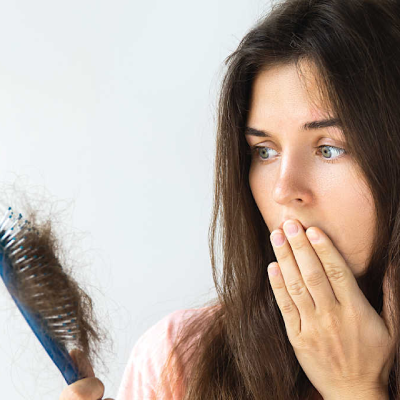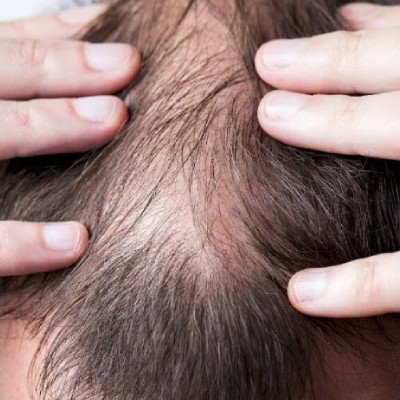Understanding Receding Hairline and Potential Treatments

08 September 2022

drgarg

Have you noticed your forehead getting higher or that the skin around it is more visible? Your sacraments? These are indications of a receding hairline in its early stages. Losing hair can be a surprise, but understanding the cause, Knowing your stage of hair loss, and knowing when to seek treatment can be helpful. Having less hair is not the only sign of a receding hairline. It is a condition that has a wide range of potential causes. Many people, both men, and women can have severe psychological effects from hair loss.
Have you noticed your forehead getting higher or that the skin around it is more visible? Your sacraments? These are indications of a receding hairline in its early stages.
Losing hair can be a surprise, but understanding the cause, Knowing your stage of hair loss, and knowing when to seek treatment can be helpful.
Having less hair is not the only sign of a receding hairline. It is a condition that has a wide range of potential causes. Many people, both men, and women can have severe psychological effects from hair loss.
This article will go through the reasons, symptoms, and efficacy of treatments for receding hairlines.
- What Causes Hair Loss and a Receding Hairline?
- How is a Receding Hairline Diagnosed?
- What are the Stages of Receding Hairline?
- Types of Hair Loss
- What is the Process of Receding Hairline?
- Do only men suffer from receding hairlines or women too?
- Treatment Options Suggested by Hair Specialists for Receding Hairline
- Conclusion
- FAQ
What Causes Hair Loss and a Receding Hairline?
On the average person's scalp, follicles under the skin's surface produce roughly 100,000 hairs. These hairs eventually fall off, and new hairs grow in their stead. Every day, you might lose dozens of hairs. A receding hairline may develop from damaged hair follicles or a medical condition that interferes with the growth cycle.
Men are more prone than women to experience a receding hairline. However, both genders might experience it. Here are other factors that may increase the likelihood of your hairline receding.
- Age Factor After puberty, hair loss can begin at any time and becomes more prevalent as people age. Women are more prone to hair loss after menopause than males, with more than half of men over 50 experiencing hair loss. Also Read: Ask The Hair Experts: Does Hair Loss Come With Aging?
- Hormonal Factor Both sexes may experience hair loss due hormonal factor. A by-product of the hormone testosterone is dihydrotestosterone (DHT). Hair loss that develops when hair follicles become susceptible to DHT is called Androgenetic Alopecia. This kind of hair loss in women may be linked to polycystic ovary syndrome, a hormonal disorder.
- Family Background A receding hairline is frequently caused by androgenetic Alopecia, a genetic hair loss. You are more likely to suffer a receding hairline and to lose hair in the same manner if you have a family history of baldness. Also Read: Got The Baldness Gene? Does It Come From Your Mother Or Father?
- Medication or Medical Care Hair loss is a known side effect of chemotherapy and radiation within a few weeks after starting treatment. Some drugs or treatments might cause hair loss as a side effect. Consult your doctor to determine whether hair loss is a potential side effect if you suspect a medication may be the cause.
You can experience temporary hair loss or a receding hairline if you've just had a stressful incident. That may encompass factors like:
- Having a baby
- Undergoing Surgery
- Traumatic Event
- Extended illness
- Severe Mental Distress resulting from various sources
Your decisions may also have an impact. A few examples include:
- Smoking
- Your hair is frequently coloured or chemically treated.
- Regularly wearing your hair back in a tight bun
- Protein in your diet is too little
- Inadequate nutritional intake or fad diets
How is a Receding Hairline Diagnosed?
Having a full head of luscious hair improves your appearance and gives you more self-assurance. But for many, the ongoing problem of a receding hairline can be upsetting. Although genetics plays a big part, early discovery and intervention are essential to solving the issue. We'll explore a receding hairline's diagnosis, review its several phases, and address some frequently asked issues in this blog.
It's not difficult to diagnose a receding hairline, but it does need close observation. Here are things to check for if you're wondering if your hairline is receding:- Hair Thinning The first sign is often a gradual hair thinning around the temples. This thinning can eventually lead to the formation of a distinct ‘M’ shape, or ‘W’ shape.
- Forehead Expansion As the hairline recedes, the forehead appears larger, creating an uneven balance.
- Widening Part When you part your hair, you might notice a wider gap between the strands, indicating further hair loss.
- Visible Scalp The most apparent sign is when your scalp becomes more visible through the thinning hair.
To confirm your diagnosis, it's advisable to consult a professional hair specialist. They can comprehensively evaluate your hair's health and suggest suitable treatments.
What are the Stages of Receding Hairline?
A receding hairline typically progresses through different stages:
- Stage 1 The earliest stage is characterised by minimal hair loss and no apparent recession.
- Stage 2 Here, the hairline starts moving backwards, and the M shape becomes noticeable.
- Stage 3 At this point, the recession deepens, creating a more pronounced M shape.
- Stage 4 The M shape widens further, and hair loss is more evident.
- Stage 5 A more significant recession with hair loss around the temples and forehead.
- Stage 6 The final stage is marked by substantial hair loss and a more extensive M shape.
Although a receding hairline may cause concern, there are treatments available. You can take proactive measures to address this worry by being aware of the stages involved in the diagnosing process and understanding them. Early intervention is crucial. Expert advice from Advanced Hair Studio will help you keep a healthy, full head of hair and recover your confidence, regardless of age—16 to 60. With Advanced Hair Studio, you can take control of your hair health and stop letting a receding hairline define you.
Types of Hair Loss
There are multiple types of hair loss, generally known as Alopecia:- Androgenic Alopecia Androgenic Alopecia is the term used to describe hereditary hair loss, including male pattern baldness and female pattern baldness. A very regular cause of hair loss because up to 50% of people might be impacted by it.
- Areata Alopecia Due to the autoimmune disease alopecia areata, your immune system attacks your hair follicles, causing little to big bald patches to appear. It might result in total hair loss in some circumstances.
- Anagen Effluvium In anagen effluvium, hair is lost quickly. Typically, radiation or chemotherapy treatments are to blame for this. Following the end of the treatment, hair normally grows back.
Hair loss brought on by androgenic Alopecia normally happens gradually. Some individuals may begin losing their hair before puberty, while others may not begin to notice symptoms until they are in their middle years, between the ages of 6 and 11.
Male baldness often causes an "M" shape to the head due to gradual hair loss above the temples and thinning towards the crown. The entire scalp frequently thins out as a result of female pattern baldness. Then my look could also be broadening or thinning around the part.
Some persons with alopecia areata also have hair loss from their brows, eyelashes, or other body regions in addition to scalp hair loss.
Also Read: Is Alopecia Areata Caused Due To Psychological Factors?
- Telogen Effluvium A traumatic experience, a prolonged period of high stress, or a catastrophic disease are examples of mental or physical shock that can cause telogen effluvium, a form of sudden hair loss. Additionally, hormonal alterations, such as those that take place in Pregnancy, childbirth, and menopause.
- Tinea Capitis Tinea capitis, often known as scalp ringworm, is a fungal infection that can harm the hair shaft and scalp. It results in tiny, scaly, irritating bald spots. These patches' size enlarges over time.
- Traction Alopecia Too much strain and tension on the hair, frequently from wearing it in tight fashions like braids, ponytails, or buns, cause traction alopecia.
- Other factors Permanent hair loss can occur due to diseases that leave scars, such as lichen planus and some varieties of lupus.
Also Read: How to Fight Traction Alopecia
What is the Process of Receding Hairline?

Men and women may have different indications and symptoms of a receding hairline, but they often go through the same stages or patterns. According to Lindsey Bordone, MD, a dermatologist at Columbia Doctors and an assistant professor of dermatology at Columbia University Irving Medical Center, some initial symptoms include "moderate thinning recession of the hairline and expansion of the portion."
Another early clue, according to Bordone, is "when individual hairs get finer and have a softer, lighter feel compared to an infant's hair." A receding hairline may initially be uneven but typically takes on an "M" shape. The crown of the head then begins to bald.These two regions eventually come together, leaving a horseshoe-shaped mark on the sides and rear of the skull.
Men's hairline thinning can be diagnosed and tracked over time using the Norwood scale. Females often use the Ludwig scale.
Do Only Men Suffer from Receding Hairlines or Women too?
When the hair near your temples starts to thin out or stops growing altogether, it causes a receding hairline resulting from hair loss. Women can have hair loss, which gives the illusion of a receding hairline, even though it is more common in men. Men and women lose hair in quite different ways, and females rarely suffer the classic receding hairline that is frequently associated with male baldness.
Treatment Options Suggested by Hair Specialists for Receding Hairline
Depending on the underlying cause, a receding hairline could be reversible. Ask an expert about your symptoms and the available treatments. If your symptoms worry you, speak with a professional, as a medical issue might bring on some types of hair loss.
- Hair Restoration A receding hairline may be surgically treated, including hairline restoration treatment. It entails transferring tiny pieces of scalp and hair follicles from the back of the head to regions where hair has stopped growing. These skin plugs may be able to grow healthy hair in their new position. Hair may continue to grow normally in the regions where the plugs were placed.
- Medications Prednisone is one medication you may need to treat an immunological problem to dampen an excessive immune response. Drugs like minoxidil (Rogaine), which is used to decrease or stop hair loss, may be beneficial. :
How Can Advanced Hair Studio Help Restore Your Hair?
With revolutionary procedures offered by the Advanced Hair Studio, our clients can rejoice in the confidence of having a head full of hair that looks natural. We harness revolutionary technologies with the help of our surgeon's expertise and years of experience. We offer hair loss solutions for every client, no matter where you are on the hair loss spectrum.We offer multiple procedures that are suited to different hair loss situations. Procedures offered by AHS Clinic include:
- AHS Laser Therapy
- Strand by Strand Cosmetic
- Strand by Strand Ultimate
- AHS Complete
FAQ
- Can receding hairline grow back? The individual and the stage of hair loss determine whether a receding hairline can be reversed. While total restoration may not be achievable in advanced stages, early intervention with hair restoration therapies can stimulate regrowth.
- Can I fix a receding hairline? A receding hairline can be managed and slowed down using effective therapies. Depending on your diagnosis and preferences, hair transplant operations, drugs, and non-surgical treatments like strand-by-strand treatment may be considered.
- Can the hairline recede at 15? Although rare, hairline receding can happen in adolescence due to stress, medical issues, or genetics. It's critical to consult a specialist for an accurate diagnosis and recommended action.
- Is my hairline receding at 16? For a precise evaluation, it is best to speak with an expert if you have early signs of hairline receding. To manage the problem, early intervention may be more beneficial.
Stay Updated
Subscribe to our email newsletter for helpful tips and valuable resourses
Be an influencer
Join forces with Advanced Hair Studio! Explore exciting collaboration opportunities tailored for influencers. Let's redefine haircare together.
Connect now












